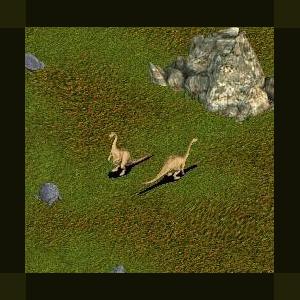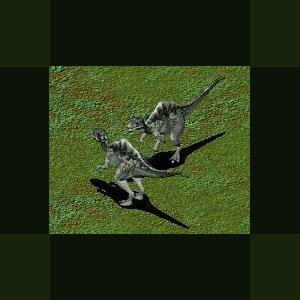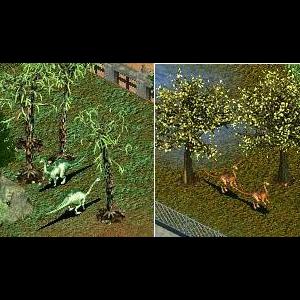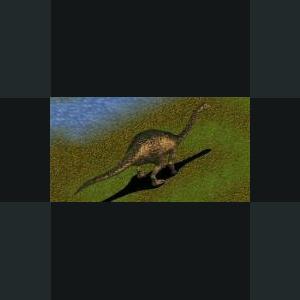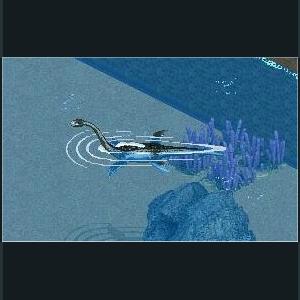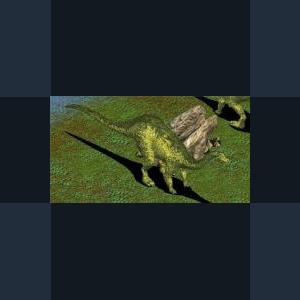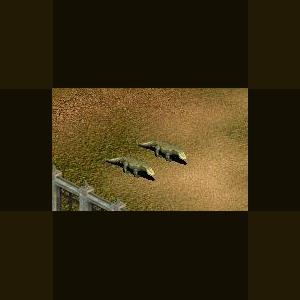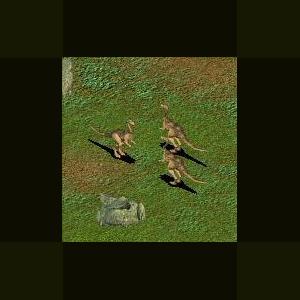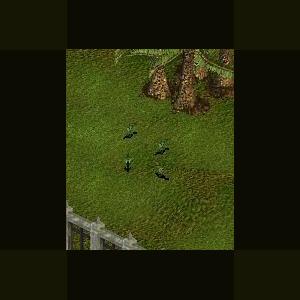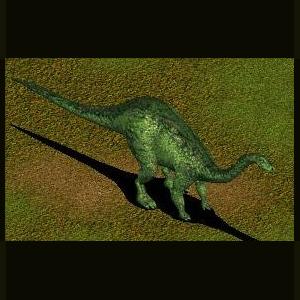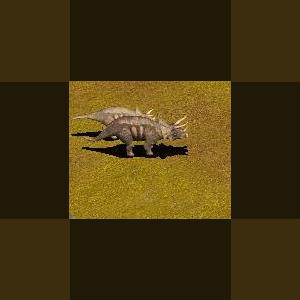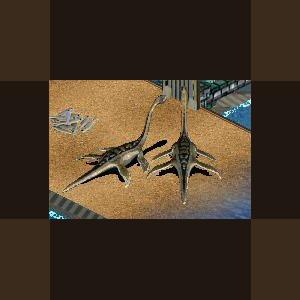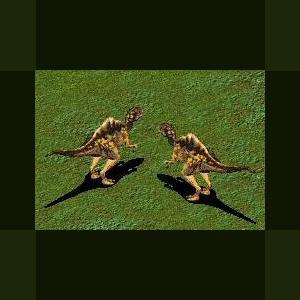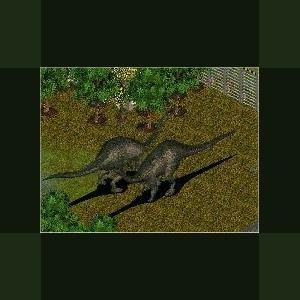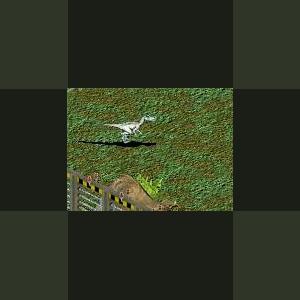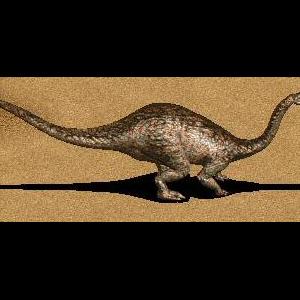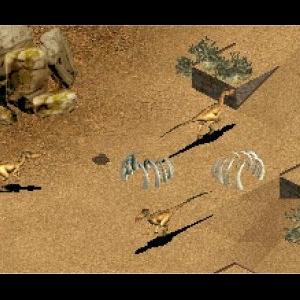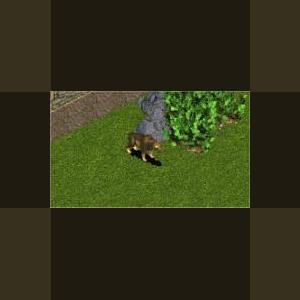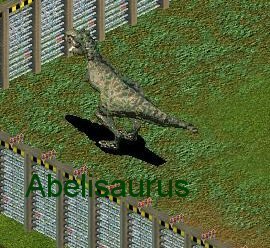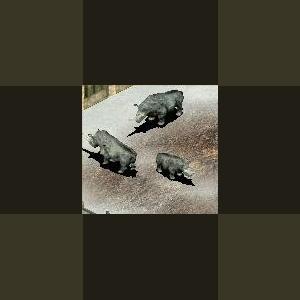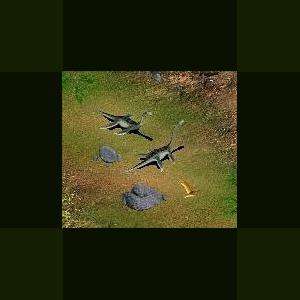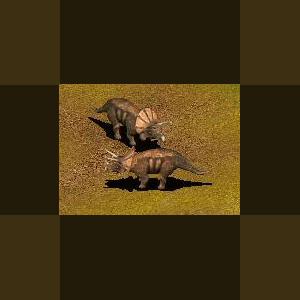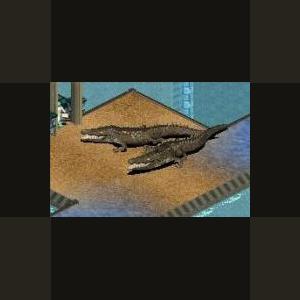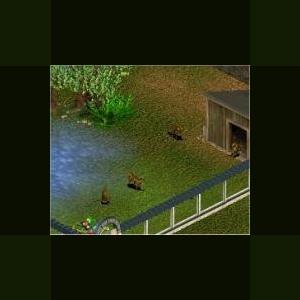Dinosaurs
Creatures from another age
241 files
-
Anchisaurus by Moondawg
By Guest
Anchisaurus (from Greek anchi-; "near, close" + Greek sauros; "lizard", probably referring to Marsh's interpretation of it as intermediate between more primitive dinosaurs [at the time Palaeosaurus was an example of what was thought to be a primitive dinosaur] and more derived dinosaurs) is a genus of prosauropod dinosaur. The name Anchisaurus was coined as a replacement name for Amphisaurus, which was a replacement name for Hitchcock's Megadactylus, both of which had already been used for other animals.
The first discovery of Anchisaurus remains was made before anything was known about dinosaurs and it was probably the first dinosaur discovery in North America. When, in 1818, some large bones were discovered in Connecticut, USA, it was assumed that they were of human origin.Gradually, as a result of further finds in Massachusetts, the number of these bones began to accumulate and, by 1855, they were at least recognized as reptilian.
Hitchcock collected these bones under the name Megadactylus in 1865. Unfortunately, the name was in use, and the famous paleontologist Othniel Charles Marsh renamed it Anchisaurus in 1885. Remains thought to belong to this genus were found in South Africa and China, adding to the theory that these land masses were at the time joined in one super-continent, Pangaea, but these assignments have been contentious (Gyposaurus). A recovery from Nova Scotia may also be an Anchisaurus but this is unconfirmed.
Today, parts of Anchisaurus' skeleton are still missing. Reconstructions usually assume that the tail and neck were prosauropod-like. Recent analyses, however, put Anchisaurus firmly at the base of the Sauropoda, making it the most basal known sauropod.
Anchisaurus was a rather small dinosaur, with a length of just over 2 metres (6.6 ft), which helps explain why it was once mistaken for human bones. It probably weighed around 27 kilograms (60 lb). However, Marsh's species A. major (also known as Ammosaurus) was larger, from 2.5 to 4 metres (8 ft 2 in to 13 ft 1 in) and some estimates give it a weight of up to 70 pounds (32 kg). All species of Anchisaurus lived during the Early Jurassic Period; more specifically, the Pliensbachian to Toarcian ages, 200 to 188 million years ago.
Digesting plant matter is a much more intensive biochemical process than digesting meat. This herbivore swallowed gastroliths (gizzard stones) to help break down the food in its stomach. Herbivorous dinosaurs needed a huge gut. Since this had to be positioned in front of the pelvis, balancing on two legs became increasingly difficult, as dinosaurs became larger and they gradually evolved into the quadrupedal position that characterizes the later sauropods such as Diplodocus. Prosauropods represented a middle phase between the earliest bipedal herbivores and the later giant sauropods. Although it was not itself a prosauropod, Anchisaurus was mostly typical of this group, which flourished briefly during the late Triassic and early Jurassic. Anchisaurus teeth, used to rip food, were shaped like spoons. It had fewer and more widely spaced teeth than true prosauropods, and as Peter Galton and Michael Cluver observed, narrower feet. Anchisaurus would have spent most of its time on four legs but could have reared up on its hind legs to reach higher plants.
On the other hand, some paleontologists believe Anchisaurus may also have eaten meat, as it was in the transition between these two ultimately distinct groups. The teeth were blunt but with file-like edges, suggesting mostly plant matter was eaten and the jaw hinge was arranged in a way not entirely suited for tearing meat. Nevertheless, there is still some debate. The thumb had a large claw and the large eyes were not entirely on the side (as would be expected in an animal of a natural prey species).
As a quadrupedal/bipedal crossover, Anchisaurus had to have multi-purpose front legs. As 'hands', they could be turned inwards and be used for grasping. It had a simple reversible first 'finger', similar to a 'thumb'. As feet, the five toes could be placed flat against the floor and were strong at the ankle. This unspecialized design is typical of the early dinosaurs.
Due to its primitive appearance, Anchisaurus was previously classified as a prosauropod, a member of a group of animals related to or ancestral to the sauropods. Recent investigations show that Prosauropoda forms a monophyletic sister-group to Sauropoda and that Anchisaurus is instead a very basal sauropod.
Marsh was originally happy with Hitchcock's name Megadactylus but this name was already taken. Therefore, he renamed it Amphisaurus in 1882. However, this name was also already in use and therefore, it became Anchisaurus in 1885.
The type species is Hitchcock's A. polyzelus. Marsh's A. major ("greater near lizard") is still often considered a valid species (as Ammosaurus) but his A. colurus (1891), once known as Yaleosaurus (von Huene, 1932), is now generally accepted as a female A. polyzelus, and his A. solus of 1892 is now reclassified as Ammosaurus major. However, Ammosaurus major itself may well be a synonym of A. polyzelus.
Broom named Gyposaurus capensis in 1911, from the bones discovered in South Africa but Peter Galton officially renamed it A. capensis in 1976. This species has since been reclassified again and is probably a juvenile of Massospondylus carinatus. G. sinensis was also referred here, but appears to be a distinct animal. Other specimens are still awaiting reclassification. This confusion is typical of the first dinosaurs to be discovered, when classification was not considered as important and precise a process as today.
333 downloads
Updated
-
Irritator by Moondawg
By Guest
Irritator is a genus of spinosaurid dinosaur that lived in the early Cretaceous Period (Albian stage), around 110 million years ago.
Current estimations indicate a length of 8 meters (26 feet) and a height of 3 meters (9 feet). It was found in Brazil. Irritator was a theropod with an unusually shaped crest at the rear of its head, and probably ate fish.
So far the only fossil that has been found was an 80 centimeter long fossil skull in the Romualdo Member, a layer member of the Brazilian Santana formation. This skull strongly resembles the skulls of Suchomimus and Spinosaurus. The genus is often regarded today as identical (synonymous) with Angaturama, which lived in the same time and the same place as Irritator.
Irritator was first scientifically described in 1996 by paleontologists Martill, Cruikshank, Frey, Small and Clarke. Its only known fossil, an 80cm skull discovered in eastern Brazil, was badly obscured by plaster which was added by the commercial fossil-collecting amateurs who discovered it, and illegally sold it, since the trade of fossils is prohibited by law in Brazil, in hopes of making the fossil look more complete and valuable. It required a great deal of work to reconstruct the original features — hence the name.
It is probably synonymous with Angaturama limai, another spinosaurid from the same time and place, whose remains curiously seem to complete Irritator's skull, meaning that they could belong to the same specimen.
Material of I. challengeri, not counting that of A. limai, hails from the Romualdo Member of the Santana Formation in Brazil. The holotype is SMNS 58022, from the Stuttgart State Museum of the Natural Sciences, and it consists of an incomplete skull, lacking the anterior (front) portion.
The skull was recovered nearly complete and is considered the most complete head find of a Spinosaurid. It is characterized particularly by its unusual length and curved lip region, which is strongly compressed laterally. The overall length of the complete head is estimated at approximately 84 centimeters. It possesses a clear Sagittal crest; such a comb is found also with some other dinosaurs. The teeth exhibit a single embedding of the strongly extended and straight teeth with conical tooth crowns, which indicates a continual tooth change, as new teeth were pushed up between the old ones. The teeth exhibit lengths from 6 to approximately 40 millimeters.
In the year 2004 parts of a spinal column were discovered in the Santana Formation. These have been assigned, due to their structure, to the Spinosauridae. With very high probability these fossils belong to Irritator, since this is the so far the only so far well-known Spinosaurid of the formation.
Sorry I couldn't make the sail smaller so i left it as is :D
305 downloads
0 comments
Updated
-
Cranky Cretaceous by Jeff
By Guest
Saltasaurus and Struthiomimus
Two wonderful dinosaurs originally released at JBL's (Jeff) old site Zooty ZT.
Struthiomimus is an omnivore, small and fast.
Saltasaurus is an herbivore.
Updated by fern and Jay Sept 2008 to add English translations done by Dizzy (thank you), making the sounds more efficient, and removing some unnecessary files.
Requires LANG--JBL.dll by fern from hacks and Utilities
(File info update 22 Nov 08)
284 downloads
0 comments
Updated
-
Rhoetosaurus by Moondawg
By Guest
Rhoetosaurus ("Rhoetos lizard"), named after Rhoetus, a Titan in Greek Mythology, was a genus of Sauropod dinosaur from the Jurassic (Middle Jurassic) of what is now eastern Australia.
Rhoetosaurus is estimated to have been about 12-15 metres long.
In 1924, Heber Longman, self-trained paleontologist at (and later director of) the Queensland Museum in Brisbane, learnt of a large fossil reptile skeleton exposed on Durham Downs Station near Roma in central Queensland. The station manager, Arthur Browne, forwarded fragments of bone to Longman, so and was honoured with the dinosaur's specific name brownei.
The initial collection was of 22 tail vertebrae, including a series of 16 consecutive bones, and other fragmentary hindlimb pieces. Soon after Longman announced the new discovery, he visited the station and arranged for more material of the same skeleton to be sent to the Queensland Museum. These included additional vertebrae from the thoracic area, bits of rib, more caudals and more of the femur and pelvis as well as a cervical vertebra.
Further material was collected by Mary Wade and Alan Bartholomai in 1975, and still more by Drs. Tom Rich, Anne Warren, Zhao Xijin, and Ralph Molnar. This additional material includes more ribs, another possible cervical vertebrae, and most of right hind limb, which is currently under study. To date, the end of the tail, forelimbs nor skull has not been found.
Along with Austrosaurus, Rhoetosaurus is among the two best-known sauropods thus far discovered in Australia, as well as for the Jurassic of Gondwana. Rhoetosaurus is presently the most complete Australian sauropod.
Inspired by the Zoo Tek Brains Trust
75 downloads
Updated
-
Prosqualodon by Ghirin
By Guest
Prosqualodon by Ghirin
Prosqualodon ("Before the Shark-Tooth") was a toothed whale that resembled a modern dolphin in both size and build. It's teeth, however, were more like the ancient shark-toothed whales than the modern toothed whales. It lived during the Oligocene and the Miocene eras.
399 downloads
0 comments
Updated
-
Elasmosaurus by Ghirin
By Guest
Elasmosaurus Author: Ghirin
Elasmosaurus ("Metal Plate Lizard") is a genus of large plesiosaurs known for their long necks. This genus contains several species with E. platyurus being the prototype specimen.
*Inspired by the Zoo Tycoon Brains Trust at the Zoo Tek Evolved Forums.*
555 downloads
0 comments
Updated
-
Alamosaurus by Moondawg
By Guest
Alamosaurus, ("meaning "Alamo lizard"), is a genus of titanosaurian sauropod dinosaur from the Late Cretaceous Period of what is now North America.
Contrary to popular assertions, this dinosaur is not named after the Alamo in San Antonio, Texas, or the battle that was fought there. The holotype, or original specimen, was discovered in New Mexico and, at the time of its naming, Alamosaurus had not yet been found in Texas. Instead, the name Alamosaurus comes from Ojo Alamo, the former name for the geologic formation in which it was found (that part of the Ojo Alamo Formation has since been reassigned to Kirtland Shale) and which was, in turn, named after the nearby Ojo Alamo trading post. The term alamo itself is a Spanish word meaning "poplar" and is used for the local subspecies of cottonwood tree. The term saurus is derived from saura , Greek for "lizard" and is the most common suffix used in dinosaur names. There is one species (A. sanjuanensis), which is named after San Juan County, New Mexico, where the first remains were found. Both genus and species were named by Smithsonian paleontologist Charles W. Gilmore in 1922.
Alamosaurus is undoubtedly a derived member of Titanosauria, but relationships within that group are far from certain. One major analysis unites Alamosaurus with Opisthocoelicaudia in a subfamily Opisthocoelicaudinae of the family Saltasauridae (Wilson, 2002). A major competing analysis finds Alamosaurus as a sister taxon to Pellegrinisaurus, with both genera located just outside Saltasauridae (Upchurch et al., 2004). Other scientists have also noted particular similarities with the saltasaurid Neuquensaurus and the BrazilianTrigonosaurus (the "Peiropolis titanosaur") which is used in many cladistic and morphologic analyses of titanosaurians (Lehman and Coulson, 2002).
377 downloads
0 comments
Updated
-
Baurusuchus by Moondawg
By Guest
Baurusuchus is an extinct genus of baurusuchid mesoeucrocodylian from the Late Cretaceous of South America.
325 downloads
Updated
-
Agilisaurus by Moondawg
By Guest
Acrocanthosaurus (pronounced ak-ro-KAN-tho-SAWR-us; meaning 'high-spined lizard') is a genus of allosauroid theropod dinosaur that existed in what is now North America during the mid-Cretaceous Period
The skull of Acrocanthosaurus, like most other allosauroids, was long, low and narrow. The weight-reducing opening in front of the eye socket (antorbital fenestra) was quite large, more than a quarter of the length of the skull and two-thirds of its height. The outside surface of the maxilla (upper jaw bone) and the upper surface of the nasal bone on the roof of the snout were not nearly as rough-textured as those of Giganotosaurus or Carcharodontosaurus. Long, low ridges arose from the nasal bones, running along each side of the snout from the nostril back to the eye, where they continued onto the lacrimal bones. This is a characteristic feature of all allosauroids. Unlike Allosaurus, there was no prominent crest on the lacrimal bone in front of the eye. The lacrimal and postorbital bones met to form a thick brow over the eye, as seen in carcharodontosaurids and the unrelated abelisaurids. Nineteen curved, serrated teeth lined each side of the upper jaw, but a tooth count for the lower jaw has not been published. Acrocanthosaurus teeth were wider than those of Carcharodontosaurus and did not have the wrinkled texture that characterized the carcharodontosaurids. The dentary (tooth-bearing lower jaw bone) was squared off at the front edge, as in Giganotosaurus, and shallow, while the rest of the jaw behind it became very deep. Acrocanthosaurus and Giganotosaurus shared a thick horizontal ridge on the outside surface of the surangular bone of the lower jaw, underneath the articulation with the skull.
235 downloads
Updated
-
Epidendrosaurus by Moondawg
By Guest
Epidendrosaurus
Epidendrosaurus ("upon-tree lizard") was a mid-Mesozoic (see "Provenance") maniraptoran dinosaur of the family Scansoriopterygidae. It was the first non-avian dinosaur found that had clear adaptations to an arboreal or semi-arboreal lifestyle--it is likely that it spent much of its time in trees. The only known specimen shows features indicating it was a juvenile. One distinctive feature of Epidendrosaurus is its elongated third finger, which is the longest on the hand, and bears a vague resemblance to the mammalian aye-aye (in most theropod dinosaurs, the second finger is the longest). Because of their juvenile nature, the size of a full-grown Epidendrosaurus is unknown. The only specimen known so far is a tiny, sparrow-sized creature. The type specimens of Epidendrosaurus contains the fossilized impression of feathers.
Kevin Padian and Alan Feduccia have treated this genus as a synonym of Scansoriopteryx, the former mistakenly treating Scansoriopteryx the junior synonym.
The only known specimen of Epidendrosaurus shows features indicating it was a juvenile. The specimen is partially disarticulated, and most bones are preserved as impressions in the rock slab, rather than three-dimensional structures.
One distinctive feature of Epidendrosaurus is its elongated third finger, which is the longest on the hand (nearly twice as long as the second finger), and may be analogous to the insect-digging finger of the mammalian aye-aye (in most theropod dinosaurs, the second finger is the longest). The only other dinosaur known to have a third finger longer than the first two is the closely related (and possibly synonymous) Scansoriopteryx. Epidendrosaurus is also notable for its wide, rounded jaws. The lower jaw contained at least twelve teeth, larger in the front of the jaws than in the back. The lower jaw bones may have been fused together, a feature otherwise known only in the oviraptorosaurs. The tail was long, six or seven times the length of the femur, and ended in a fan of feathers.
Because the specimen is a juvenile, the size of a full-grown Epidendrosaurus is unknown–the type specimen is a tiny, sparrow-sized creature.
Epidendrosaurus belongs to the family Scansoriopterygidae ("climbing wings"), though the exact taxonomic placement of this family is uncertain. Studies of dinosaur relationships have found Epidendrosaurus to be a close relative of true birds and a member of the clade Avialae.
There has been some degree of uncertainty regarding the status of the name Epidendrosaurus. The type specimen was described online in the online version of the journal Naturwissenschaften on 2002-08-21, while the identical print version (except for the date) was not published until 2002-09-30. However a very similar specimen named Scansoriopteryx heilmanni was described in the 2002-08-01 issue of The Dinosaur Museum Journal.
These two specimens are so similar that they may be the same genus, in which case a strict interpretation of Article 21 of the International Code of Zoological Nomenclature (ICZN) would give priority to Scansoriopteryx. However, the journal in which Scansoriopteryx appeared has a very small circulation and the issue was not distributed until roughly 2002-09-02, well after the electronic appearance of Epidendrosaurus. The conflict is used as an example in a proposed amendment to the ICZN that would consider electronic articles with Digital Object Identifiers (DOIs) that are subsequently available in print to qualify as "publication" for naming purposes. In scientific literature, the genus Scansoriopteryx has been treated as a senior synonym of Epidendrosaurus by Alan Feduccia and as a junior synonym by Kevin Padian.
The holotype specimen of Epidendrosaurus ninchengensis consists mostly of bone imprints in both part and counter part. Impressions indicate a relatively long tail, unlike the apparently short tail seen in Scansoriopteryx.
The fossilized skeleton of Epidendrosaurus was recovered from the Daohugou fossil beds of northeastern China. In the past, there has been some uncertainty regarding the age of these beds. Various papers have placed the fossils here anywhere from the Middle Jurassic period (169 million years ago) to the Early Cretaceous period (122 ma). The age of this formation has implications for the relationship between Epidendrosaurus and similar dinosaurs, as well as for the origin of birds in general. A Middle Jurassic age would mean that the bird-like dinosaurs in the Daohugou beds are older than the "first bird", Archaeopteryx, which was Late Jurassic in age. The provenance of Scansoriopteryx is uncertain, though Wang et al. (2006), in their study of the age of the Daogugou (see below), suggest that it probably hails from the same beds, and thus is likely a synonym of Epidendrosaurus.
A 2004 study by He et al. on the age of the Daohugou Beds found them to be Early Cretaceous, probably only a few million years older than the overlying Jehol beds of the Yixian Formation, where Scansoriopteryx was found. The 2004 study primarily used radiometric dating of a tuff within the Daohugou Bed to determine its age. However, a subsequent study by Gao & Ren took issue with the He et al. study. Gao and Ren criticized He et al. for not including enough specifics and detail in their paper, and also took issue with their radiometric dating of the Daohugou tuff. The tuff, Gao and Ren argued, contained crystals with a variety of diverse radiometric ages, some up to a billion years old, so using dates from only a few of these crystals could not determine the overall age of the deposits in which Epidendrosaurus (along with the other Daohugou fossils) were found. Gao and Ren went on to defend a Middle Jurassic age for the beds based on biostratigraphy (the use of index fossils) and the bed's relationship to a layer that is known to mark the Middle Jurassic-Late Jurassic boundary.
Another study, published in 2006 by Wang et al., found that the Tiaojishan Formation (159-164 million years old) underlies, rather than overlies, the Daohugou Beds. After taking into account the great similarity between the Daohugou fauna and the fauna of the Yixian Formation, the authors concluded that the Daohugou probably represents the earliest evolutionary stages of the Jehol Biota, and that it "belongs to the same cycle of volcanism and sedimentation as the Yixian Formation of the Jehol Group." Later in 2006, Liu et al. published their own study of the age of the Daohugou beds, this time using Zircon U-Pb dating on the volcanic rocks overlying and underlying salamander-bearing layers (salamanders are often used as index fossils). Liu et al. found that the beds formed between 164-158 million years ago, in the Middle to Late Jurassic.
Epidendrosaurus is cited as being an arboreal (tree-dwelling) maniraptoran based on the elongated nature of the hand and specializations in the foot.[3] The authors state that the long hand and strongly curved claws are adaptations for climbing and moving around among tree branches. They view this as an early stage in the evolution of the bird wing, stating that the forelimbs became well-developed for climbing, and that this development later lead to the evolution of a wing capable of flight. They state that long, grasping hands are more suited to climbing than to flight, since most flying birds have relatively short hands.
Zhang et al. also noted that the foot of Epidendrosaurus is unique among non-avian theropods. While the Epidendrosaurus specimen does not preserve a reversed hallux, the backward-facing toe seen in modern perching birds, its foot was very similar in construction to more primitive perching birds like Cathayornis and Longipteryx. These adaptations for grasping ability in all four limbs makes it likely that Epidendrosaurus spent a significant amount of time living in trees.
The type specimen of Epidendrosaurus also preserved faint feather impressions at the end of the tail, similar to the pattern found in the dromaeosaurid Microraptor. While the reproductive strategies of Epidendrosaurus itself remain unknown, several tiny fossil eggs discovered in Phu Phok, Thailand (one of which contained the embryo of a theropod dinosaur) may have been laid by a small dinosaur similar to Epidendrosaurus or Microraptor. The authors who described these eggs estimated the dinosaur they belonged to would have had the adult size of a modern Goldfinch.
166 downloads
0 comments
Updated
-
Nigersaurus by Moondawg
By Guest
Nigersaurus (meaning Niger lizard) was a relatively small sauropod (15 meters long) that was described in 1999, and which lived in the middle Cretaceous period, about 119-99 million years ago.
It is one of the most common genera found in the rich fossil vertebrate fauna of the Elrhaz Formation, Gadoufaoua, in the Niger Republic, discovered by Philippe Taquet, and described in a paper published in 1976. Like other sauropods from what used to be Gondwana, it had a shorter neck than Laurasian sauropods like Barosaurus. Nigersaurus had to protect itself from carnivores such as Sarcosuchus.
Nigersaurus (meaning Niger lizard) is a genus of diplodocoid sauropod dinosaur from the middle Cretaceous period, about 119 to 99 million years ago during the Aptian or Albian age. This dinosaur was described by Paul Sereno and colleagues in 1999. It is one of the most common genera found in the rich fossil vertebrate fauna of the Elrhaz Formation, Gadoufaoua, in the Niger Republic, discovered by Philippe Taquet, and described in a paper published in 1976.
Nigersaurus was a plant-eater that had an unusual mouth shaped like the wide intake slot of a vacuum that took in food and over a hundred very small, sharp teeth for chewing. Previously, such tooth batteries have been known only in hadrosaur and ceratopsian dinosaurs, but the discovery of Nigersaurus showed that at least one sauropod lineage, the rebbachisaurids, had them, as well.
Like other sauropods from what used to be Gondwana, it had a shorter neck than Laurasian sauropods like Barosaurus. Despite these stockier proportions, Nigersaurus reached about 9 meters (29.5 ft) in length. At nine meters in length, Nigersaurus was smaller than other members of the Rebbachisaur family, such as Rebbachisaurus itself, a large animal with a distinctive low spinal ridge on its back. Nigersaurus, although smaller, had a similar ridge, which in life would have consisted of skin and perhaps also flesh stretched across elongate neural spines in the vertebrae.
Although a common genus, Nigersaurus had been poorly known until 2005, because of the delicate and highly pneumatic (filled with air spaces) construction of the skull and skeleton, which means that the fossil remains have been disarticulated. Sereno and Jeffrey A. Wilson in 2005 provided the first description of the skull and feeding adaptations. Nigersaurus had as many as 500 or 600 teeth in its shovel-shaped head. Like the earlier diplodicids, its head was oriented downwards and was best suited for low level browsing.
According to the New York Times, an article published in the Public Library of Science (PLoS) in late November 2007 details the unique anatomy of Nigersaurus. The genus is reported to have had a relatively short neck with the head oriented towards the ground; it is thought to have been a ground-level browser like a modern cow. The Times reports
In contrast to other plant-eating dinosaurs, this one had more than 50 columns of teeth, all lined up along the jaws’ front edges, forming, in effect, foot-long scissors. The CT scans of the jawbones showed up to nine replacement teeth stacked behind each cutting tooth. When one wore out, another immediately took its place, at a rate, perhaps, of one a month in each column. 'Among dinosaurs,' Dr. Sereno said, 'Nigersaurus sets the Guinness record for tooth replacement.'
176 downloads
0 comments
Updated
-
Arrhinoceratops by Moondawg
By Guest
Arrhinoceratops belonged to the Ceratopsinae (previously known as Chasmosaurinae) within the Ceratopsia (the name is Ancient Greek for "horned face"), a group of herbivorous dinosaurs with parrot-like beaks which thrived in North America and Asia during the Cretaceous Period, which ended roughly 65 million years ago. It appears to be closely related to Torosaurus.
Since this dinosaur is known only from its skull, scientists know little about its over-all anatomy. The skull features a broad neck frill with two oval shaped openings.
Its brow horns were moderately long, but its nose horn was shorter and blunter than most Ceratopsians
Its body is assumed to be typical of the Ceratopsians, and based on the skull it is estimated to be 6 m (20 ft) long when fully grown.
Arrhinoceratops, like all Ceratopsians, was a herbivore. During the Cretaceous, flowering plants were "geographically limited on the landscape", and so it is likely that this dinosaur fed on the predominant plants of the era: ferns, cycads and conifers. It would have used its sharp Ceratopsian beak to bite off the leaves or needles.
359 downloads
0 comments
Updated
-
Futabasaurus Suzukii by Moondawg
By Guest
Futabasaurus Suzukii is the name of a plesiosaur that was described in 2006 by Sato, Hasegawa, and Manabe.
Futabasaurus comes from the Late Cretaceous of Fukushima, Japan, and was assigned to the family Elasmosauridae.
The name Futabasaurus also appears in connection with a theropod dinosaur, also from the Late Cretaceous of Japan. However, this dinosaur was not officially named, so the name Futabasaurus is a nomen nudum when applied to this theropod. It is not the same as the plesiosaur named Futabasaurus.
342 downloads
0 comments
Updated
-
Suchomimus by Moondawg
By Guest
Suchomimus
Suchomimus ("crocodile mimic") is a genus of large spinosaurid dinosaur with a crocodile-like mouth that lived 110 to 120 million years ago, during the middle portion of the Cretaceous period in Africa.
Unlike most giant theropods, Suchomimus had a very long, low snout and narrow jaws studded with some 100 teeth, not very sharp and curving slightly backward. The tip of the snout was enlarged and carried a "rosette" of longer teeth. The animal is reminiscent of crocodilians that eat mainly fish, such as the living gharial, a type of large crocodile with a very long, slim snout, from the region of India.
Suchomimus also had a tall extension of its vertebrae which may have held up some kind of low flap, ridge or sail of skin, as seen in much more exaggerated form in Spinosaurus. Detailed study shows that the specimen of Suchomimus was a subadult about 11 meters (36 ft) in length, but scientists think that it may have grown to about 12 meters (40 ft) long, approaching the size of Tyrannosaurus. The overall impression is of a massive and powerful creature that ate fish and presumably other sorts of meat (carrion, if naught else) more than 100 million years ago, when the Sahara was a lush, swampy habitat.
Suchomimus has been placed among the spinosaurids, a group of predator-scavengers adapted for hunting fish but with frail bone structures (particularly their skulls), especially when compared to other similarly sized theropods, like the tyrannosaurids. Apart from the back ridge, Suchomimus was very similar to the spinosaurid Baryonyx which also had strong forelimbs and a huge sickle-curved claw on its "thumb". And, as with Baryonyx, the claw was the first fossil part to be noticed by palaeontologists. Suchomimus was considerably larger than Baryonyx, but a few paleontologists have suggested that the latter might almost have been a juvenile of the former.
After discovering new specimens of Carcharodontosaurus and Sarcosuchus, Chicago-based palaeontologist Paul Sereno and his team added a discovery in 1997. In the Sahara, near the Tenere Desert in Niger, they found fossils that represented about two-thirds of the skeleton of a huge meat-eater. This was named Suchomimus ("crocodile mimic") after the shape of its head.
390 downloads
0 comments
Updated
-
Diplodocus by Ghirin
By Guest
Diplodocus ("Double Beam") was one of the sauropods found during the North American "Bone Rush" of the late 1800's. At that time, Diplodocus was the longest known dinosaur, though more recently discovered dinosaurs such as Supersaurus are longer. Even with its great length, Diplodocus was relatively light-weight (compared to Barosaurus and Apatosaurus).
Diplodocus' long, sloping skull became the type for a group of dinosaurs with similar skulls (the Diplodocidae). Other important features of Diplodocus include a long tail with a whip-like ending (possibly an anti-predator defense), a long neck, and skid-like projections on the vertebra of the middle tail region.
References:
http://dinosauricon....diplodocus.html
Encyclopedia of Dinosaurs and Other Prehistoric Creatures. Malam and Parker, 2002
Dinosaurs. Parker, 2003
Created by Ghirin 2004
368 downloads
0 comments
Updated
-
Utahraptor by Moondawg
By Guest
Utahraptor (meaning "Utah's predator") is the largest known member of the theropod dinosaur family
Dromaeosauridae, and dates from the upper Barremian stage of the Early Cretaceous period (132-119 million years ago).
Like other dromaeosaurids, Utahraptor had a huge curved claw on the second toe that could grow to 23 centimetres (9.1 in) long. The animal may have grasped its prey with its forelimbs while kicking with its hindlimbs. Recent tests on reconstructions of the smaller Velociraptor suggest that claws of this type were used for stabbing or suffocating its prey, not slashing into their hide.Up to 6.5 m (21 ft) long, 2 m (6.6 ft) tall, and 700 kg (1,500 lb) in weight, Utahraptor would have been a formidable predator.
Updated by Cricket on April 5, 2012:
Removed space from name
Removed extra verbiage
348 downloads
Updated
-
Aegyptosaurus by Moondawg
By Guest
Aegyptosaurus meaning 'Egypt’s lizard', where it was discovered is a genus of dinosaur believed to have lived in what is now Africa, around 95 million years ago, during the mid- and late-Cretaceous Period.
351 downloads
0 comments
Updated
-
Desert Velociraptor by Ghirin
By Guest
Desert Velociraptor
Author: Ghirin
During the late Cretaceous Period, the area now known as the Gobi Desert had a semi-arid climate. The fossils of many species of dinosaurs have been found there, such as Protoceratops, Oviraptor, and Velociraptor.
Velociraptor was a fierce predator that might have lived in hunting packs. A fossil of a Velociraptor and a Protoceratops locked in battle indicates that this therapod was a predator of Protoceratops.
Reference:
Encyclopedia of Dinosaurs and Other Prehistoric Creatures. Malam and Parker, 2003
Created by Ghirin 2004
443 downloads
0 comments
Updated
-
Barbourofelis Fricki by Ghirin
By Guest
Barbourofelis fricki
Author: Ghirin
Barbourofelis fricki ("Barbour's Cat") was a lion-sized member of the genus Barbourofelis from the family Nimravidae. Even though Barbourofelis strongly resembled the saber-toothed cats, the nimravids are no longer considered to be true felines due to distinct anatomical differences and are sometimes referred to as paleo-sabers or false saber-toothed cats.
Barbourofelis fricki was one of the last of the genus and roamed the North American grasslands approximately 6 million years ago.
285 downloads
0 comments
Updated
-
Abelisaurus by Moondawg
By Savannahjan
Abelisaurus ("Abel's lizard") is a genus of abelisaurid theropod dinosaur from the Late Cretaceous Period of what is now South America.
The generic name recognizes Roberto Abel as the discoverer of the specimen and former director of the provincial Museum of Cipolletti in Argentina, where the specimen is housed. It also incorporates the Greek sauros, meaning 'lizard'. There is one named species, A. comahuensis, which honors the Comahue region of Argentina, where the fossil was found. Both genus and species were named and described by Argentine paleontologists Jose Bonaparte and Fernando Novas in 1985, who placed it in the newly-created family Abelisauridae.
Many other abelisaurids have since been discovered, including extremely complete specimens of Aucasaurus, Carnotaurus and Majungasaurus. Some scientists place Abelisaurus as a basal abelisaurid, outside the subfamily Carnotaurinae. Others are less certain of its position.Abelisaurids share some skull features with the unrelated carcharodontosaurids and, since Abelisaurus is known only from a skull, future discoveries may show that this genus was in fact a carcharodontosaurid. However, this is thought unlikely.
The one known fossil skull of Abelisaurus is incomplete, especially on the right side. It is also missing most of the palate (roof of the mouth). Despite the missing pieces, it is over 85 centimeters (33 inches) long. Although there are no bony crests or horns, like those found in some other abelisaurids, such as Carnotaurus, rough ridges on the snout and above the eyes might have supported some kind of crest made out of keratin, which wouldn't have become fossilized. There are also very large fenestrae (window-like openings) in the skull, which are found in many dinosaurs and reduce skull weight
Abelisaurus is one of the many dinosaurs that have been discovered in Patagonia. It was originally described as coming from the Allen Formation but subsequent research proved the remains were actually found in the older Anacleto Formation (part of the Neuquén Group) of Rio Negro Province, Argentina. The Anacleto is a geologic formation in South America, dating from the early Campanian stage of the Late Cretaceous Period, between 83 and 80 million years ago.
95 downloads
Updated
-
Elasmotherium by Moondawg
By Guest
Elasmotherium ("Thin-Plate Beast") was a genus of giant rhinoceri which stood, on average, two meters (7 feet) high and six meters (20 feet) long, with a single two-meter-long horn in the forehead.
The genus appeared during the Late Pliocene in Central Asia, being derived from the genus Sinotherium. E. inexpectatum and E. peii inhabited Eastern China during the Upper Pliocene to Early Pleistocene. They disappeared approximately 1.6 Ma. The earliest records of Elasmotherium species in Russia are known from the Upper Pliocene assemblages near the Black Sea. E. caucasicum was widely distributed in this area between 1.1 Ma and 0.8 Ma. The more advanced (and largest member of the genus) E. sibiricum appeared in the Middle Pleistocene. It occupied all of the southwestern part of Russia, reaching eastward to western Siberia, then south into Ukraine and Moldova. Elasmotherians persisted in eastern Europe until the end of the Middle Pleistocene.
Made by request for Pukkie
375 downloads
0 comments
Updated
-
Ceresiosaurus by Moondawg
By Guest
Ceresiosaurus
Ceresiosaurus, meaning "Lizard of Ceres", is an extinct genus of aquatic sauropterygian reptile belonging to the nothosaur order. It was about 4 m (13 ft) long and its fossils have been found in Europe, and was named by Bernhard Peyer in 1931.
Ceresiosaurus existed during the middle Triassic period during the Anisian stage.
Ceresiosaurus was much more elongated than its relatives, and had fully developed flippers with no trace of visible toes. The finger bones in its flippers had multiplied (hyperphalangy) and elongated, giving the reptile much longer flippers than most nothosaurs. Ceresiosaurus's flippers greatly resembled those of the later plesiosaurs, an aquatic reptile family of which the nothosaurs were an early offshoot. Also noteworthy of Ceresiosaurus was that its skull is the shortest known of any nothosaur, giving it an appearance that made it the most plesiosaur-looking of the nothosaurs.
Although possessing a long neck and tail, Ceresiosaurus may not have been a reptile that swam via undulation; analysis of the bone structure in regards to the hips and powerful tail suggest that it instead propelled itself through the water much like a penguin. The evidence of pachypleurosaurs in the preserved stomach of Ceresiosaurus remains lend credence to the theory of it being a fast swimmer.
Olivier Rieppel suggested that Ceresiosaurus is a synonim of Lariosaurus
276 downloads
Updated
-
Chasmosaurus by Moondawg
By Guest
Chasmosaurus (KAZ-mo-sawr-us) is a ceratopsid dinosaur genus from the Upper Cretaceous Period of North America.
Ceratopsians are split into two subfamilies by taxonomists; those with short frills
(centrosaurines), such as Centrosaurus and those with long frills (chasmosaurines), of
which Chasmosaurus was one. In addition to the larger frill, the long-frilled ceratopsians
typically had longer faces and jaws and it is suggested by some paleontologists that they
were more selective about the plants they ate. Long frills were a relatively late
development in dinosaur evolution, since even Chasmosaurus dates from the late Cretaceous
Period, 76 to 70 million years ago. The frill of Chasmosaurus has been described as
"heart-shaped", since its bone structure consists of two large 'loops' from a central bone.
Some finds include a number of smaller ossifications (called epoccipitals), which may have
grown from the perimeter of the frill. The frill may also have been brightly colored, to
draw attention to its size or as part of mating display. However, the frill was so large
and yet so flimsy (since it was mainly skin stretched between the bones) that it could not
have provided much functional defense. It is possible that it was simply used to appear
imposing or conceivably for thermoregulation. In the event of a chasmosaur herd being
attacked by a predator (such as Tyrannosaurus), the males could have formed a ring and,
with all the frills facing outwards, would have presented a formidable sight.
A drawing of Chasmosaurus.Like many ceratopsians, chasmosaurs had three main facial horns - one on the nose and two on the brow. Different fossil finds have produced inconclusive
results - one species of Chasmosaurus, named C. kaiseni, bore long brow horns, while C. belli had only short ones. Although these were initially named as different species, it now seems possible that the long horns belonged to males and the shorter horns to females.
Interestingly, a Chasmosaurus specimen recovered by Sternberg was accompanied by
fossilized skin.The skin appears to have had many bony knobs (osteoderms) in evenly spaced rows, with five or six sides per knob. Unfortunately, nothing can be learned about the coloration of Chasmosaurus from the known fossil skin samples.
Inspired by the Zoo Tek Brains Trust
238 downloads
Updated
-
Purussaurus by Moondawg
By Guest
Purussaurus was a giant caiman living in South America, 20 million years ago (Miocene). It is only known from skull material found in Peruvian Amazonia.
The skull is about 1.5 meters (5 ft), and paleontologists estimate that the whole body would have measured around 15 meters (50 ft), which means that Purussaurus is one of the largest crocodilians known to have ever existed. Two other extinct crocodilians, Sarcosuchus and Deinosuchus, have similar proportions, but both are geologically much older, dating from the Early and Late Cretaceous, respectively. During the summer of 2005, a franco-peruvian expedition (the Fitzcarrald expedition) found new fossils of Purussaurus in Amazonia (600 km from Lima).
Purussaurus was a giant caiman living in South America during the Miocene epoch, 8 million years ago. It is known from skull material found in the Brazilian, Colombian and Peruvian Amazonia, besides in the north of Venezuela. The skull is about 1.5 meters (5 ft) long, and paleontologists estimate that the whole body would have measured around 12 meters, which means that Purussaurus is one of the largest crocodilians known to have ever existed. Two other extinct crocodilians, Sarcosuchus and Deinosuchus, have similar proportions, but both are geologically much older, dating from the Early and Late Cretaceous, respectively, and another from around the same era, the Rhamphosuchus, is also estimated to be of similar size. During the summer of 2005, a Franco-Peruvian expedition (the Fitzcarrald expedition) found new fossils of Purussaurus in Amazonia (600 km from Lima).
309 downloads
Updated
-
Aegyptopithecus by Ghirin
By Guest
Aegyptopithecus by Ghirin
Aegyptopithecus was an early hominid that lived in what is now modern day Egypt.
At that time, Egypt was much more wet and humid.
Reference:
http://www.johnhawks.net/weblog/fossils/ap...egyptopithecus/
256 downloads
0 comments
Updated

